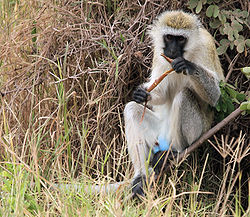Portal:Primates
The Primates Portal A primate is a member of the biological order Primates, the group that contains lemurs, the aye-aye, lorisids, galagos, tarsiers, monkeys, and apes, with the last category including great apes. With the exception of humans, who inhabit every continent on Earth, most primates live in tropical or subtropical regions of the Americas, Africa and Asia. Primates range in size from the 30-gram (1 oz) pygmy mouse lemur to the 200-kilogram (440 lb) mountain gorilla. According to fossil evidence, the primitive ancestors of primates may have existed in the late Cretaceous period around 65 mya (million years ago), and the oldest known primate is the Late Paleocene Plesiadapis, c. 55–58 mya. Molecular clock studies suggest that the primate branch may be even older, originating in the mid-Cretaceous period around 85 mya. Primates exhibit a wide range of characteristics. Some primates do not live primarily in trees, but all species possess adaptations for climbing trees. Locomotion techniques used include leaping from tree to tree, walking on two or four limbs, knuckle-walking, and swinging between branches of trees (known as brachiation). Primates are characterized by their large brains relative to other mammals. These features are most significant in monkeys and apes, and noticeably less so in lorises and lemurs. Many species are sexually dimorphic, which means males and females have different physical traits, including body mass, canine tooth size, and coloration.
Selected article
Chimpanzee, sometimes colloquially chimp, is the common name for the two extant species of ape in the genus Pan. The Congo River forms the boundary between the native habitat of the two species, the common chimpanzee (Pan troglodytes), the more numerous and better known that lives primarily in West and Central Africa, and the bonobo (Pan paniscus), also known as the "pygmy chimpanzee or Bonzi chimpanzee", found in the forests of the Democratic Republic of the Congo.
Chimpanzees are members of the Hominidae family, along with gorillas, humans, and orangutans. Chimpanzees split from human evolution about 6 million years ago and thus the two chimpanzee species are the closest living relatives to humans, all being members of the Hominini tribe (along with extinct species of Hominina subtribe). Chimpanzees are the only known members of the Panina subtribe. The two Pan species split only about one million years ago. Selected picture The white-fronted capuchin, Cebus albifrons, is a species of capuchin monkey, a type of New World primate, found in seven different countries in South America: Bolivia, Brazil, Colombia, Venezuela, Ecuador, Peru, and Trinidad and Tobago. The species is divided into several different subspecies, though the specific divisions are uncertain and controversial. CategoriesSelected species Least Concern (IUCN 3.1)|Least Concern The vervet monkey (Chlorocebus pygerythrus), or simply vervet, is an Old World monkey of the family Cercopithecidae native to Africa. The term "vervet" is also used to refer to all the members of the genus Chlorocebus. The five distinct subspecies can be found mostly throughout Southern Africa, as well as some of the eastern countries. Vervets were transported to the islands of Barbados, Saint Kitts, and Nevis in conjunction with the African slave trade. These mostly vegetarian monkeys have black faces and grey body hair color, ranging in length from about 19 in (50 cm) for males to about 16 in (40 cm) for females. In addition to very interesting behavioral research on natural populations, vervet monkeys serve as a nonhuman primate model for understanding genetic and social behaviors of humans. They have been noted for having human-like characteristics, such as hypertension, anxiety, and social and dependent alcohol use. The most significant studies done on vervet monkeys involve their communication and alarm calls, specifically in regard to kin and group recognition and particular predator sightings. Did you know?
Primate lists
WikiProjectsThings to do
Associated WikimediaDiscover Wikipedia using portals |

















